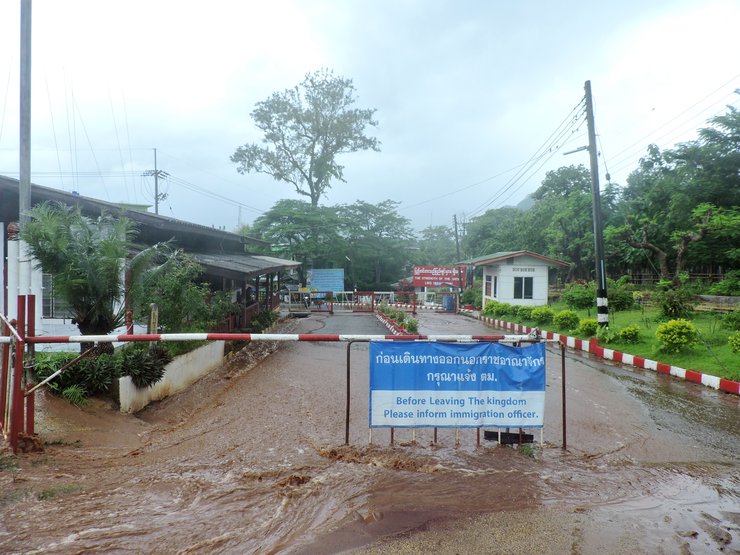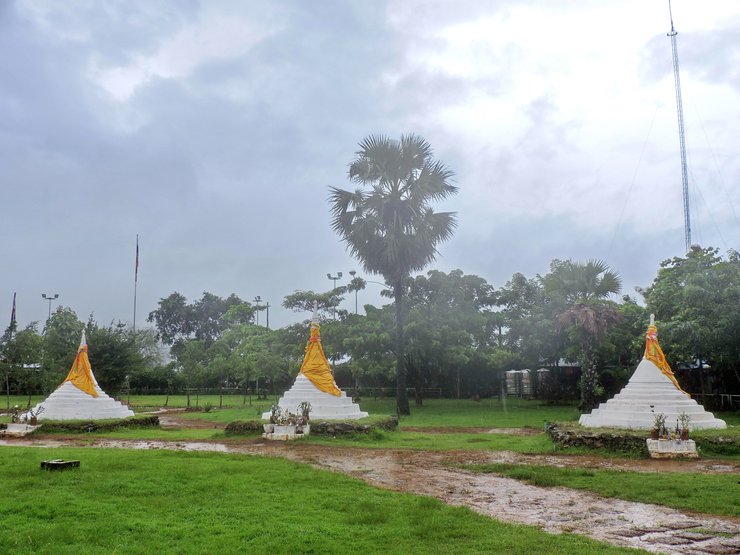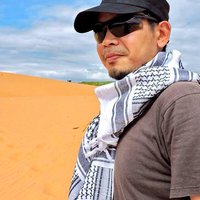Day 1
Departed from Bangkok at approximately 8:00 AM.
Arrived at the "Three Pagodas Pass" at approximately 2:00 PM.
The distance from Bangkok to the Three Pagodas Pass is approximately 380 kilometers.
Three Pagodas Pass
Three Pagodas Pass is located in Nong Lu Subdistrict, marking the westernmost border of Thailand. It separates Thailand from Myanmar, specifically the northern part of Kanchanaburi Province from the southern part of Kayin State. Historically, it served as a crucial route for military campaigns during the Thai-Burmese wars.

Sangkhla Buri Immigration Checkpoint

It rained heavily on the day of travel.



Thai-Japan Peace Hall
( THE BORDER PEACE TEMPLE THAI - JAPAN )

Three Pagodas Pass

Three Pagodas Pass Border Market

Plant Shop - Wild Orchids

The surrounding area offers a variety of souvenirs and jewelry for sale.



The Siam's End at Three Pagodas Pass Checkpoint

After strolling around the "Three Pagodas Pass", head to tonight's accommodation.
Bun Suay Saeng Suk
Air conditioning + TV + water heater. Price 600 baht/night (excluding breakfast).

The atmosphere inside the room


Outdoor atmosphere





After packing, I started to feel hungry and decided to stop by for some food.
My go-to choice: "หมูกระทะ" (Thai BBQ).
Baramee Moo Kata
This small restaurant is located near the 134th Border Patrol Police Company. It offers a wide variety of menu options, and the food is delicious.




The atmosphere is perfect. Rain is falling and the hot pot is steaming hot.

Full of food, we continued walking through the market.






Why are there so many people here? Let's go take a look.

Burmese-style hot pot

They will dip the ears, meat, and pork offal into a large pot of hot soup.
Empty cups are provided for scooping the soup. The price is only 1 baht per skewer.

End of the night, return to accommodation
Day 2
Good morning! It has been raining since last night and there is no sign of it stopping. I couldn't go to the Mon market to offer alms.

The rain has stopped, let's head to the Mon Bridge.
Walk along the red bridge, on the right is the Sam Prasop Resort.


U Ttamanusorn Bridge (Mon Bridge)
This wooden bridge spans the Songkalia River, connecting visitors to the Mon village. It holds the title of the longest wooden bridge in Thailand.
The bridge stands as a testament to the faith and collaborative spirit of the Sangkhla Buri community.




Water hyacinth


Walking under the bridge to play



Along the way, a young boy approached and asked if anyone wanted to be powdered. He was carrying equipment, including Thanaka powder and stencils with various designs. The powdering was free, and photos were allowed. He accepted any amount of money that people were willing to give.


Note: The original text is empty, so the translation is also empty.


A view from the bridge shows the Mon side.

The way of life of the people in this area






Tourists are riding a boat.

Songkhla Bridge
This bridge is used to cross the Songkhla River. If you want to drive to Wat Wang Wiwekaram or the Buddhist Mahabodhi Pagoda, you have to use this bridge.




I really like this gang. They are so funny to talk to.




We have arrived at the Mon market.







Let's have breakfast first.


Postcard only 20฿


Full now, let's get to work today.


I have selected 3 temples for a price of 500 baht.
Wat Wang Wiwekaram (Old)
Wat Somdet (Old)
Wat Si Suwannaram (Old)

This boat has a roof that can protect you from the sun and rain.

The boat driver was very kind and friendly, providing excellent information about the various locations.

Departed.


Looking from the boat to the shore.



It only takes a few minutes to reach the first destination, Wat Wang Wiwekaram (Old).



Wat Wang Wiwekaram (Old)
In 1984, the Electricity Generating Authority of Thailand (EGAT) initiated the construction of the Vachiralongkorn Dam, also known as the Khao Laem Dam, for electricity generation. When the dam was filled, the water level rose and submerged the old district, covering an area of over 1,000 rai. More than 1,000 Mon villagers' houses, including the original Wat Wang Wiwekaram, were affected. The authorities evacuated the affected villagers from the flooded area and relocated the temple to a hill on the west bank of the Kwae Noi River. The original temple site was left submerged, becoming known as the "Submerged Temple" or "Sunken City," a major Unseen Thailand tourist attraction.







































After leaving the first temple, I realized I had been walking for a while and apologized to the boat driver. He smiled and said it was no problem, as tourists don't come here every day.

Continue to the second temple



After a short boat ride, we arrived at Wat Somdet (Old).


Fish are available for release at the entrance.

Entrance

Incense, candles, and flowers are available for purchase on the side.

The Old Wat Somdet
The Old Wat Somdet, located on a small hill opposite the town of Ba Da, is a temple that was not submerged by the waters of the Vajiralongkorn Dam (Khao Laem Dam). However, it was abandoned when the Sangkhla Buri district was relocated during the dam's construction.


The main Buddha statue is in relatively good condition.




Around the church



Continue the journey to the 3rd temple




The Mahabodhi Temple is visible.

Wat Si Suwan (Old)
A temple representing the Karen people, sharing the same name as Phra Si Suwannakhiri, the title of the governor of Sangkhla Buri. The temple is located at the end of the Ran Tee River.


It is recommended to wear sandals as you will need to wade through water.

Interior atmosphere










When you reach the three points, you can tell the boat driver which side you want to stop at: the Thai side or the Mon side.


Departing from the Mon Bridge, head towards Wat Wang Wiwekaram.
Wat Wang Wiwekaram
Wat Wang Wiwekaram, also known as Wat Luang Pho Uttama, is a temple built by Luang Pho Uttama, along with Karen and Mon villagers, in 1953. It is located in Ban Wang Ka, Sangkhla Buri District, Kanchanaburi Province, near the Thai-Myanmar border.

A melting pot of cultures, the district of Sangkhla Buri is home to a diverse population of Thai, Karen, and Mon people, who find unity in this shared space.




Nine-Spires Pagoda
The coffin containing the remains of Luang Pho Uttama and a statue of Luang Pho Uttama

Ubosot of Wat Wang Wiwekaram


Departing from "Wat Wang Wiwekaram", head towards the "Buddha Gaya Pagoda"
approximately 600 meters away
Buddha Gaya Pagoda (Replica)
This replica of the Buddha Gaya Pagoda in India was constructed with funds donated by devotees in the form of cash, gold, and materials. The construction involved the labor of both men and women from the village.


The top of the pagoda enshrines the relics of the Lord Buddha, which Luang Pho Uttama invited from Sri Lanka. They are two pieces of the right thumb bone, white with a slight yellow tinge, the size of a grain of rice.






Near the parking lot, there is a souvenir shop where you can buy gifts and souvenirs, such as Thanaka powder in both ready-made and wooden stick forms, jewelry, scarves, bags, snacks, tea, and coffee from Burma.

Heading back to Bangkok!
On the way, we stopped by the Kering Krewia Waterfall.
Kering Krewia Waterfall
This small waterfall is located along Highway 323, the main route from Thong Pha Phum to Sangkhla Buri. It's a popular rest stop for travelers, with shops and restaurants available.


The water flows down in a curtain-like manner, not very high.





Thank you all for watching.
Let's be friends at...
FACEBOOK : https://www.facebook.com/poom.evolution.9
Apisit Poom Sukpakdee
Tuesday, October 8, 2024 11:17 AM



















